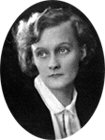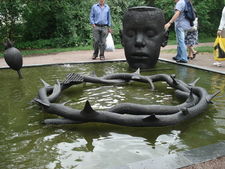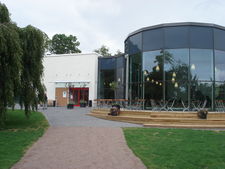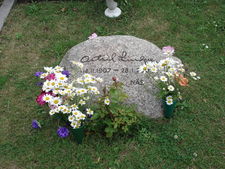Astrid Lindgren
| Astrid Lindgren | |
|---|---|
 |
|
| Born | Astrid Anna Emilia Ericsson 14 November 1907 Vimmerby, Småland, Sweden |
| Died | 28 January 2002 (aged 94) Stockholm, Sweden |
| Occupation | Children's book author |
| Language | Swedish |
| Nationality | Swedish |
Astrid Anna Emilia Lindgren (née Ericsson) (listen to pronunciation, 14 November 1907 – 28 January 2002) was a Swedish author and screenwriter who is the world's 25th[1] most translated author and has sold roughly 145 million[2] copies worldwide. She is best known for the Pippi Longstocking, Karlsson-on-the-Roof and the Six Bullerby Children[3] book series.
Contents |
Biography

Astrid Lindgren grew up in Näs, near Vimmerby, Småland and many of her books are based on her family and childhood memories and landscapes. However, Pippi Longstocking, one of her most famous characters, was invented to please her daughter Karin, who was, at the time, ill and bed-ridden, and was placed rather in Gotland.
Lindgren was the daughter of Samuel August Ericsson and Hanna Johnsson. She had two sisters. Her brother, Gunnar Ericsson, was a member of the Swedish parliament. Upon finishing school, Lindgren took a job with the a local newspaper in Vimmerby. When she became pregnant with the chief editor's child in 1926, he proposed marriage. She demurred and moved to Stockholm, learning to become a typist and stenographer. In due time she gave birth to her son Lars in Copenhagen and left him in the care of a foster family.
Although poorly paid, she saved whatever she could and travelled as often as possible to Copenhagen to be with Lars, often just over a weekend, spending most of her time on the train back and forth. Eventually, she managed to bring Lars home, leaving him in the care of her parents until she could afford to raise him in Stockholm. In 1931 she married her boss, Sture Lindgren (1898-1952). Three years later, in 1934, Lindgren gave birth to her second child, Karin, who became a translator. The family moved in 1941 to an apartment on the Dalagatan, with a view over Vasaparken, where Astrid lived until her death in 2002, at the age of 94[4].
Lindgren was almost blind a few years before her death.
Career
Lindgren worked as a journalist and secretary before becoming a full time author. She served as a secretary for the 1933 Swedish Summer Grand Prix.
In 1944 Lindgren won second prize in a competition held by the newly founded publishing house Rabén & Sjögren with her novel Britt-Marie lättar sitt hjärta (Britt-Marie unburdens her heart). A year later she won first prize in the same competition with the children's book Pippi Långstrump (Pippi Longstocking), which has since become one of the most beloved children's books in the world. She had already sent Pippi Longstocking to the Bonniers publishing house but it was rejected. While Lindgren almost immediately became a much appreciated writer, the irreverent attitude towards adult authority that is a distinguishing characteristic of many of her characters has occasionally drawn the ire of some conservatives.
The women's magazine Damernas Värld sent Lindgren to the USA in 1948 to write short essays. Upon arrival she is said to have been upset by the discrimination against African Americans. A few years later she published the book Kati in America, a collection of short essays inspired by the trip.
In 1956, she won the Deutscher Jugendliteraturpreis.
In 1958, Lindgren became the second recipient of the Hans Christian Andersen Award, an international award for youth literature. On her 90th birthday, she was pronounced Swede of the Year by a radio show.
In its entry on Scandinavian fantasy, The Encyclopedia of Fantasy named Lindgren the foremost Swedish contributor to modern children's fantasy.[5] Its entry on Lindgren summed up her work in glowing terms: "her niche in children's fantasy remains both secure and exalted. Her stories and images can never be forgotten."[6]
Politics

In 1976, a scandal arose in Sweden when Lindgren's marginal tax rate was publicized to have risen to 102%. This was to be known as the "Pomperipossa effect" from a story she published in Expressen[7] on 3 March 1976. The publication led to a stormy tax debate. In the parliamentary election later in the same year the Social Democrat government was voted out for the first time in 44 years, and the Lindgren tax debate was one of several controversies that may have contributed to this result.
Astrid Lindgren was well known both for her support for children's and animal rights, and for her opposition to corporal punishment. In 1994, she received the Right Livelihood Award (also known as the Alternative Nobel Prize), "...For her commitment to justice, non-violence and understanding of minorities as well as her love and caring for nature."
Honors and memorials
In 1967, Rabén & Sjögren established an annual literary prize, the Astrid Lindgren Prize, in connection with her 60th birthday. The prize, SEK 40,000, is awarded to a Swedish language children's author, every year on her birthday in November.
Following Lindgren's death, the government of Sweden instituted the Astrid Lindgren Memorial Award in her memory. The award is the world's largest monetary award for children's and youth literature, in the amount of five million SEK.
The collection of Astrid Lindgren's original manuscripts in Kungliga Biblioteket (the Royal Library), Stockholm, was placed on UNESCO's World heritage list in 2005.
"Asteroid Lindgren"
A minor planet, 3204 Lindgren, discovered in 1978 by Soviet astronomer Nikolai Stepanovich Chernykh, was named after her.[8] The name of the Swedish microsatellite Astrid 1, launched on 24 January 1995, was originally selected only as a common Swedish female name, but within a short time it was decided to name the instruments after characters in Astrid Lindgren's books: PIPPI (Prelude in Planetary Particle Imaging), EMIL (Electron Measurements - In-situ and Lightweight), and MIO (Miniature Imaging Optics). Astrid said that maybe people should call her Asteroid Lindgren instead.
"Astrid's Wellspring"

In memory of Astrid Lindgren, a memorial sculpture was created next to her childhood home, named "Källa Astrid" ("Astrid's Wellspring" in English). It is situated at the same place where Astrid Lindgren first heard fairy tales.
It consists of an artistic representation of a young person's head (1.37m high),[9] flattened on top, in the corner of a square pond, and, just above the water, a ring of rosehip thorn (with a single rosehip bud attached to it). The sculpture was initially slightly different in design and intended to be part of a fountain set in the city center, but the people of Vimmerby vehemently opposed the idea. Astrid Lindgren furthermore had stated that she never wanted to be represented as a statue. (However, there is a statue of Lindgren in the city center.) The memorial was sponsored by the culture council of Vimmerby.
Lindgren's childhood home is near the statue and open to the public.[10] Just 100 metres from "Astrid's Wellspring" is a museum in her memory. The author is buried in Vimmerby where the Astrid Lindgrens World theme park is also located. The children's museum Junibacken, Stockholm, was opened in June 1996, with the main theme of the permanent exhibition being devoted to Astrid Lindgren: the heart of the museum is a theme train ride through the world of Astrid Lindgren's novels.


Bibliography
The best-known books by Astrid Lindgren:
- The Pippi Longstocking series (Pippi Långstrump)
- Karlsson-on-the-Roof series (Karlsson på taket)
- Emil of Lönneberga (Emil i Lönneberga)
- The Bill Bergson series (Mästerdetektiven Blomkvist)
- Madicken
- Ronia the Robber's Daughter (Ronja rövardotter)
- Seacrow Island (Tjorven Vi på Saltkråkan)
- The Six Bullerby Children / The Children of Noisy Village (Barnen i Bullerbyn)
- Mio, my Mio (also known as Mio, my Son) (Mio, min Mio)
- The Brothers Lionheart (Bröderna Lejonhjärta)
An alphabetically sorted list of other books by Astrid Lindgren which have been translated into English:
- A Calf for Christmas
- Brenda Helps Grandmother
- The Children of Noisy Village
- The Children on Troublemaker Street
- Christmas in Noisy Village
- Christmas in the Stable
- Circus Child
- The Day Adam Got Mad
- Dirk Lives in Holland
- The Dragon With Red Eyes
- Gerda Lives in Norway
- Emil and the Bad Tooth
- Emil and His Clever Pig
- Emil Gets into Mischief
- Emil in the Soup Tureen
- Emil's Little Sister
- Emil's Pranks
- Emil's Sticky Problem
- The Ghost of Skinny Jack
- Happy Times in Noisy Village
- I Don't Want to Go to Bed
- I Want a Brother or Sister
- I Want to Go to School Too
- Kati in America
- Kati in Italy
- Kati in Paris
- Lotta
- Lotta's Bike
- Lotta's Christmas Surprise
- Lotta's Easter Surprise
- Lotta Leaves Home
- Lotta on Troublemaker Street
- Markos Lives in Yugoslavia
- Marje
- Marje to the Rescue
- Matti Lives in Finland
- Mirabelle
- Mischievous Martens
- Mischievous Meg
- Most Beloved Sister
- My Nightingale Is Singing
- My Swedish Cousins
- My Very Own Sister
- Nariko-San, Girl of Japan
- Noby Lives in Thailand
- Rasmus and the Vagabond (aka Rasmus and the Tramp)
- The Red Bird
- The Runaway Sleigh Ride
- Scrap and the Pirates
- Sea Crow Island
- Siva Lives on Kilimanjaro
- Simon Small Moves In
- Springtime in Noisy Village
- That's Not My Baby
- The Tomten
- The Tomten and the Fox
- The World's Best Karlson
- Kajsa Kavat
Filmography
This is a chronological list of feature films based on stories by Astrid Lindgren:[11][12]
- Mästerdetektiven Blomkvist (1947) - director: Rolf Husberg
- Pippi Långstrump (1949) - director: Per Gunwall
- Mästerdetektiven och Rasmus (1953) - director: Rolf Husberg
- Luffaren och Rasmus (1955) - director: Rolf Husberg
- Rasmus, Pontus och Toker (1956) - director: Stig Olin
- Mästerdetektiven lever farligt (1957) - director: Olle Hellbom
- Alla vi barn i Bullerbyn (1960) - director: Olle Hellbom
- Bara roligt i Bullerbyn (1961) - director: Olle Hellbom
- Vi på Saltkråkan (1964 TV series, 1968 theatrical release) - director: Olle Hellbom
- Tjorven, Båtsman och Moses (1964) - director: Olle Hellbom
- Tjorven och Skrållan (1965) - director: Olle Hellbom
- Tjorven och Mysak (1966) - director: Olle Hellbom
- Skrållan, Ruskprick och Knorrhane (1967) - director: Olle Hellbom
- Malysh i Karlson (1968) - director: Boris Stepantsev
- Pippi Långstrump (1969, edited from 1968-69 TV series) - director: Olle Hellbom
- Här kommer Pippi Långstrump (1969, edited from 1968-69 TV series) - director: Olle Hellbom
- Karlson vernulsya (1970) - director: Boris Stepantsev
- På rymmen med Pippi Långstrump (1970) - director: Olle Hellbom
- Pippi Långstrump på de sju haven (1970) - director: Olle Hellbom
- Emil i Lönneberga (1971) - director: Olle Hellbom
- Nya hyss av Emil i Lönneberga (1972) - director: Olle Hellbom
- Emil och griseknoen (1973), Emil and the Piglet - director: Olle Hellbom
- Världens bästa Karlsson (1974) - director: Olle Hellbom
- Priklyucheniya Kalle-syschika (1976) - director: Arūnas Žebriūnas
- Bröderna Lejonhjärta (1977) - director: Olle Hellbom
- Du är inte klok, Madicken (1979) - director: Göran Graffman
- Madicken på Junibacken (1980) - director: Göran Graffman
- Rasmus på luffen (1981) - director: Olle Hellbom
- Peppi Dlinnyychulok (1982) - director: Margarita Mikaelyan
- Ronja Rövardotter (1984) - director: Tage Danielsson
- Emila nedarbi (1985) - director: Varis Brasla
- Alla vi barn i Bullerbyn (1986) - director: Lasse Hallström
- Mer om oss barn i Bullerbyn (1987) - director: Lasse Hallström
- Mio, min Mio (1987) - director: Vladimir Grammatikov
- Kajsa Kavat (1988) - director: Daniel Bergman
- The New Adventures of Pippi Longstocking (1988) - director: Ken Annakin
- Godnatt herr luffare! (1988) - director: Daniel Bergman
- Allra käraste syster (1988) - director: Göran Carmback
- Inga rövare finns i skogen (1988) - director: Göran Carmback
- Gull-Pian (1988) - director: Staffan Götestam
- Hoppa högst (1988) - director: Johanna Hald
- Nånting levande åt Lame-Kal (1988) - director: Magnus Nanne
- Peter och Petra (1989) - director: Agneta Elers-Jarleman
- Nils Karlsson Pyssling (1990) - director: Staffan Götestam
- Pelle flyttar till Konfusenbo (1990) - director: Johanna Hald
- Lotta på Bråkmakargatan (1992) - director: Johanna Hald
- Lotta 2 – Lotta flyttar hemifrån (1993) - director: Johanna Hald
- Kalle Blomkvist – Mästerdetektiven lever farligt (1996) - director: Göran Carmback
- Kalle Blomkvist och Rasmus (1997) - director: Göran Carmback
- Pippi Långstrump (1997, animated) - director: Clive Smith
- Pippi i Söderhavet (1999) - director: Paul Riley
- Karlsson på taket (2002, animated) - director: Vibeke Idsøe
See also
- Astrid Lindgren Memorial Award
- List of Swedish language writers
Notes
- ↑ UNESCO's statistics on whole Index Translationum database
- ↑ FAQ at Astrid Lindgren official site (in Swedish)
- ↑ In the US, the Children of Noisy Village series.
- ↑ Source - Steinar Mæland
- ↑ John-Henri, Holmberg (1997/1999), "Scandinavia", in Clute, John, and John Grant, The Encyclopedia of Fantasy, New York: St. Martin's Griffin, pp. 841.
- ↑ John-Henri, Holmberg (1997/1999), "Lindgren, Astrid (Anna Emilia)", in Clute, John, and John Grant, The Encyclopedia of Fantasy, New York: St. Martin's Griffin, pp. 582.
- ↑ Astrid Lindgren timeline, 1974-76.
- ↑ Dictionary of Minor Planet Names - p.256
- ↑ "Källa Astrid” på Astrids källa "Astrid's Wellspring [source of inspiration in Astrid's Wellspring."] Kinda-Posten (in Swedish)
- ↑ Vălkommen Till Astrid Lindgrens Năs
- ↑ Films based on Astrid Lindgren stories (in Swedish)
- ↑ Astrid Lindgren at IMDb
References
- Astrid Lindgren - en levnadsteckning. Margareta Strömstedt. Stockholm, Rabén & Sjögren, 1977.
- Paul Berf, Astrid Surmatz (ed.): Astrid Lindgren. Zum Donnerdrummel! Ein Werk-Porträt. Zweitausendeins, Frankfurt 2000 ISBN 3-8077-0160-5
- Vivi Edström: Astrid Lindgren. Im Land der Märchen und Abenteuer. Oetinger, Hamburg 1997 ISBN 3-7891-3402-3
- Maren Gottschalk: Jenseits von Bullerbü. Die Lebensgeschichte der Astrid Lindgren. Beltz & Gelberg, Weinheim 2006 ISBN 3-407-80970-0
- Jörg Knobloch (ed.): Praxis Lesen: Astrid Lindgren: A4-Arbeitsvorlagen Klasse 2-6, AOL-Verlag, Lichtenau 2002 ISBN 3-89111-653-5
- Sybil Gräfin Schönfeldt : Astrid Lindgren. 10. ed., Rowohlt, Reinbek 2000 ISBN 3-499-50371-9
- Margareta Strömstedt: Astrid Lindgren. Ein Lebensbild. Oetinger, Hamburg 2001 ISBN 3-7891-4717-6
- Astrid Surmatz: Pippi Långstrump als Paradigma. Die deutsche Rezeption Astrid Lindgrens und ihr internationaler Kontext. Francke, Tübingen, Basel 2005 ISBN 3-7720-3097-1
- Metcalf, Eva-Maria: Astrid Lindgren. New York, Twayne, 1995.
External links
- Astrid Lindgren's works — Official site produced by license holders
- Astrid Lindgren at the Internet Movie Database
- Astrid Lindgren's World — Amusement Park official site
- Astrid Lindgrens Näs — Official site produced by the Astrid Lindgren-museum and culture center Astrid Lindgrens Näs in Vimmerby
- Astrid Lindgren — Right Livelihood Award (1994)
- Astrid Lindgren — A fan site
- Astrid Lindgren (1907-2002) — Biography of Astrid Lindgren. Includes bibliography, with date and English translation of title.
- Astrid spacecraft description — NASA's National Space Science Data Center site